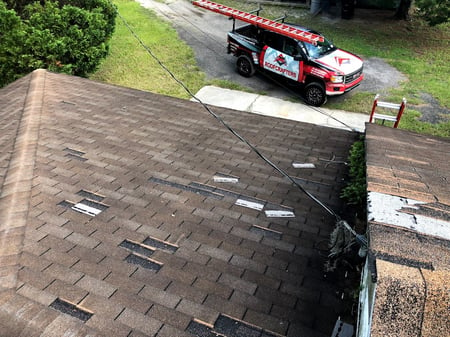How to Tell If Winter in the Southeast Took a Toll on Your Roof
April , 2025 | 6 min. read
By Mitch Owens

Winter in the Southeast might not come with the heavy snow loads and bone-chilling temperatures you’d find up north, but don’t let the milder climate fool you, your roof still takes a beating.
From torrential downpours and surprise cold snaps to gusty winds and pesky ice dams, The RoofCrafters team knows that Southeastern winters can quietly wreak havoc on your home’s first line of defense.
So how do you know if your roof came out of winter unscathed, or if it’s hiding a few secrets? Let’s walk through the signs, explain what’s happening behind the scenes, and go over what you should do next to keep your roof in top shape, shall we?
Southeast Winters Are Sneakier Than You Think

While we may not be digging ourselves out of snowdrifts, the Southeast’s winter conditions can still cause real damage. Think about it: Shifting temperatures, moisture-heavy storms, and the occasional freeze can combine forces to weaken even the sturdiest roof over time.
The challenge is that roof issues caused by winter weather aren’t always obvious right away. Sometimes, the signs are subtle. Sometimes, they’re downright invisible… until a leak appears in your living room ceiling.
How Winter Weather Impacts Southeastern Roofs
Let’s break down the main culprits behind winter roof wear and tear in the Southeast:
Freeze-Thaw Cycles
Even though true snowstorms are rare down here, freezing temperatures at night followed by warmer afternoons can cause moisture to seep into small cracks or loose shingles. When that moisture freezes, it expands, widening gaps and creating long-term structural vulnerabilities. This process, called the freeze-thaw cycle, is a sneaky one, especially on older roofs.
Heavy Rain and Wind
Rain is a regular winter guest in the Southeast, and combined with strong wind, it can push water under shingles, into flashing, or beneath poorly sealed areas. This not only leads to leaks but can also promote mold and rot if left unchecked.
Fallen Debris
With trees staying fuller longer and then suddenly shedding branches during storms, it’s common for limbs to land on roofs or clog gutters. Over time, debris can cause shingle damage, disrupt drainage, and create pressure points on your roof’s surface.
Ice Dams (Yes, They Can Happen Here!)
You might think ice dams are just a northern problem, but they can form in the Southeast during cold snaps. If your attic is poorly insulated, warm air can melt snow or ice on your roof, which then refreezes at the edge, forming a dam that prevents proper drainage.
How to Tell If Winter Took a Toll on Your Roof

Okay, now that we’ve covered what could go wrong, let’s talk about how to spot the signs of damage. You don’t need to be a roofing pro to do a basic post-winter checkup. Here’s what to look for:
Shingle Check
Grab a pair of binoculars and scan your roof from the ground. Look for:
- Missing or cracked shingles
- Curling or buckling shingles
- Areas where granules seem to be missing (you’ll notice dark patches or a smoother texture)
Shingle damage is one of the most common after-effects of wind and moisture stress.
Flashing Failures
Flashing is the thin metal used around vents, chimneys, and skylights. It’s your roof’s unsung hero when it comes to waterproofing. If flashing is loose, bent, or rusted, water may have found a way inside during the winter.
Gutter Grit & Debris
Take a peek in your gutters. If you find lots of shingle granules (they look like coarse black sand), that’s a sign your shingles are aging or were damaged by storms. Also, make sure gutters and downspouts are clear, as clogs can lead to improper drainage and water pooling on your roof.
Water Stains or Leaks Inside
This one’s a no-brainer. If you see brownish spots on your ceiling or walls (or worse, active dripping), you’ve got a roof leak. And chances are, it started brewing during the winter. Don’t wait on this one. Leaks rarely fix themselves.
Mold or Mildew Around the Roofline
Sometimes moisture damage doesn’t show up as a drip, it shows up as discoloration, mildew, or a musty smell in your attic. These are all red flags that water has been hanging around where it shouldn’t be.
Sagging or Uneven Rooflines
From a distance, your roofline should look straight and even. If you notice any dips or sags, it could be a sign of water damage beneath the surface, especially if your home had heavy rainfall this winter.
What To Do Next: Your Roof Recovery Plan

If you’ve spotted any of the above signs, or even if everything looks okay but your roof is over 10 years old, it’s worth scheduling a professional roof inspection. A trained eye can spot hidden issues and help you avoid costly repairs down the line. Here’s a quick to-do list to help get your roof spring-ready:
Schedule a Professional Inspection
A reputable roofing company can assess storm damage, perform minor repairs, and give you a clear picture of your roof’s health moving forward. Bonus points if they take time-stamped photos (very helpful for insurance purposes).
Clear Off Debris
If there are sticks, leaves, or branches hanging around, have them safely removed to prevent water retention or added weight on your shingles.
Check Your Attic
Look for damp insulation, mold, or soft spots in the wood. Your attic can tell you a lot about what’s going on with your roof, especially when it comes to leaks or poor ventilation.
Seal and Caulk
Ask your roofer to reseal any areas around vents, chimneys, or skylights that may have loosened during winter. These are common leak points.
Plan Ahead
If your roof is getting up there in age or took a decent beating this winter, start planning for future repairs or replacement now before summer storms roll in. Spring is actually a great time to get roofing work done.
Don’t Sleep on Your Spring Roof Check
Even in the Southeast, where winter is more bark than bite, your roof can still suffer from the season’s wear and tear. By staying proactive and spotting issues early, you can save yourself from bigger, more expensive problems later on.
Whether you’re just doing a visual check or calling in the pros, a little springtime roof maintenance can go a long way. Because when it comes to your home, peace of mind starts at the top.
Want to make sure your roof is ready for the seasons ahead? Be sure to hit that “Schedule an Inspection” button down below, and we’ll let you know exactly what’s going on up there without the guesswork.
My name is Mitch, and I have over 10 years of roofing experience. I enjoy my career in the service industry because I love helping others take care of their homes and businesses. With over 10 years in the roofing industry, my success comes from my honesty and integrity during my roof inspections. I do my best to listen to the needs of my clients and strive to provide an awesome client experience.




